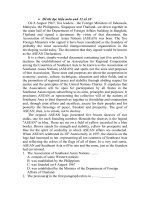- Trang chủ >>
- Đề thi >>
- Đề thi lớp 12
Đề thi đọc hiểu môn anh 12 số 10
Bạn đang xem bản rút gọn của tài liệu. Xem và tải ngay bản đầy đủ của tài liệu tại đây (70.48 KB, 2 trang )
Đề thi đọc hiểu môn anh 12 số 10
On 8 August 1967, five leaders - the Foreign Ministers of Indonesia,
Malaysia, the Philippines, Singapore and Thailand- sat down together in
the main hall of the Department of Foreign Affairs building in Bangkok,
Thailand and signed a document. By virtue of that document, the
Association of Southeast Asian Nations (ASEAN) was born. The five
Foreign Ministers who signed it have been considered as the founders of
probably the most successful intergovernmental organization in the
developing world today. The document that they signed would be known
as the ASEAN Declaration.
It is a short, simply-worded document containing just five articles. It
declares the establishment of an Association for Regional Cooperation
among the Countries of Southeast Asia to be known as the Association of
Southeast Asian Nations (ASEAN) and spells out the aims and purposes
of that Association. These aims and purposes are about the cooperation in
economy, society, culture, techniques, education and other fields, and in
the promotion of regional peace and stability through abiding respect for
justice and the principles of the United Nations Charter. It stipulates that
the Association will be open for participation by all States in the
Southeast Asian region subscribing to its aims, principles and purposes. It
proclaims ASEAN as representing the collective will of the nations of
Southeast Asia to bind themselves together in friendship and cooperation
and, through joint efforts and sacrifices, secure for their peoples and for
posterity the blessings of peace, freedom and prosperity. The goal of
ASEAN, then, is to create, not to destroy.
The original ASEAN logo presented five brown sheaves of rice
stalks, one for each founding member. Beneath the sheaves is the legend
"ASEAN" in blue. These are set on a field of yellow encircled by a blue
border. Brown stands for strength and stability, yellow for prosperity and
blue for the spirit of cordiality in which ASEAN affairs are conducted.
When ASEAN celebrated its 30
th
Anniversary in 1997, the sheaves on the
logo had increased to ten -representing all ten countries of Southeast Asia
and reflecting the colors of the flags of all of them. In a very real sense,
ASEAN and Southeast Asia will be one and the same, just as the founders
had envisioned.
1. The Association of Southeast Asian Nations …….
A. consists of some Western nations
B. was established by the Philippines
C. was founded on 8 August 1967
D. was established by the Minister of the Department of Foreign
Affairs of Thailand
2. The pronoun it in the first paragraph refers to …….________.
A. the Association of Southeast Asian Nations B. the most successful
inter-governmental organization
C. Bangkok D. the ASEAN Declaration
3. Which adjective can be used to describe the Association of Southeast
Asian Nations?
A. successful B. illegal C. nongovernmental
D. developing
4. Which does not belong to the purpose and aim of the Association of
Southeast Asian Nations?
A. friendship B. destruction C. creation
D. cooperation
5. Up to 1997 how many countries there have been in ASEAN?
A. 5 B. 6 C. 8 D.
10
KEY: 1. C 2. D 3. A 4. B 5. D









